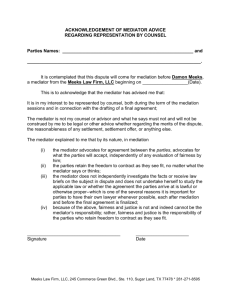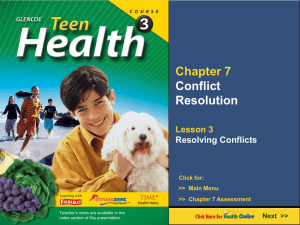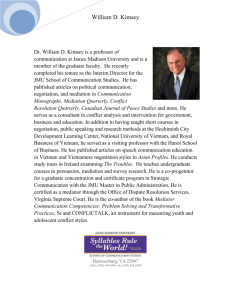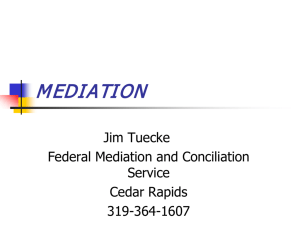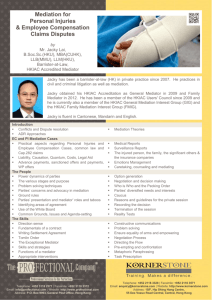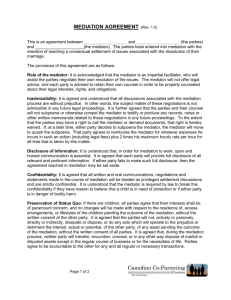Agenda - Conflict Resolution Education Connection
advertisement
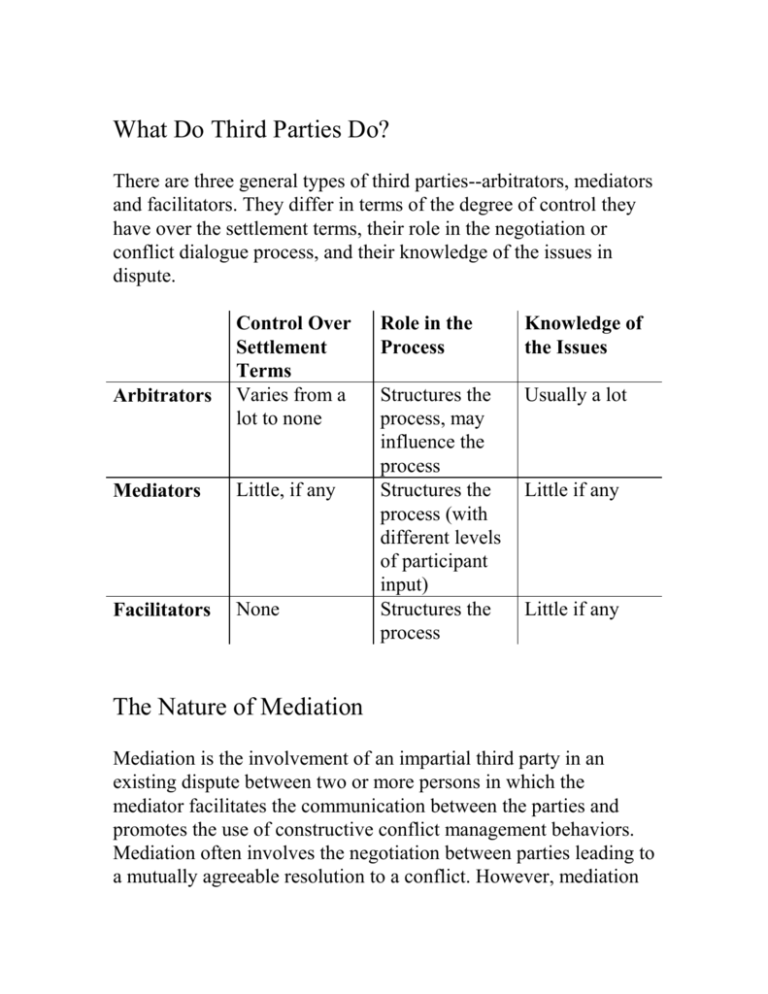
What Do Third Parties Do? There are three general types of third parties--arbitrators, mediators and facilitators. They differ in terms of the degree of control they have over the settlement terms, their role in the negotiation or conflict dialogue process, and their knowledge of the issues in dispute. Arbitrators Control Over Settlement Terms Varies from a lot to none Mediators Little, if any Facilitators None Role in the Process Knowledge of the Issues Structures the process, may influence the process Structures the process (with different levels of participant input) Structures the process Usually a lot Little if any Little if any The Nature of Mediation Mediation is the involvement of an impartial third party in an existing dispute between two or more persons in which the mediator facilitates the communication between the parties and promotes the use of constructive conflict management behaviors. Mediation often involves the negotiation between parties leading to a mutually agreeable resolution to a conflict. However, mediation MEDIATING WITH HEART IN MIND 2 can be worthwhile even if no negotiated agreement is sought or is forthcoming from the process. When Mediation is Appropriate A skilled mediator is present Participants are willing to mediate Extremely destructive relational patterns are absent The balance of power between the parties is relatively equal There are incentives to parties to try and make the situation better and/or to solve the problem(s) The Mediator’s Job Although there are different opinions about the style that a mediator should adopt, most people agree that a mediator has two general roles: Facilitates communication by helping the parties talk together effectively Encourages the parties to use constructive, integrative conflict management behaviors Tricia S. Jones and Andrea Bodtker, Temple University, 2000. Please do not reproduce or use in part or whole without written permission. MEDIATING WITH HEART IN MIND 3 Mediator Strategies Mediators use many communication strategies to do their job well. Here we present three general strategies and the basic tactics that comprise them. The Communication-Facilitation Strategy This strategy is designed to enhance communication between the parties. These are process-oriented behaviors that help the mediator understand the nature of the conflict. This strategy is used throughout mediation but if often emphasized in the first stages of mediation. There are three common tactics in this strategy: The Search for Information about the nature of the conflict and the overall relationship between the parties Instruction about the mediation process and constructive conflict management behaviors Supportive Communication to decrease defensiveness, aid the disputant’s in saving face, and establish trust in the mediator. The Substantive-Directive Strategy This strategy is designed to involve the mediator in the discussion of substantive issues in the conflict. These are content-oriented behaviors. This strategy has four basic tactics. Suggestions/recommendations for Action Reality Testing designed to help the disputants realize options for action and the consequences of actions. Tricia S. Jones and Andrea Bodtker, Temple University, 2000. Please do not reproduce or use in part or whole without written permission. MEDIATING WITH HEART IN MIND 4 Empowerment Tactics that improve parties’ ability to get what they want or need. Formalization of Final Agreement which allows the mediator to make explicit the specifics of the agreement, if any, reached between the parties. The Procedural Strategy This strategy constructs an efficient procedure for the flow of communication. It consists of three tactics: Agenda-setting is proposing an order for the discussion of issues. Caucusing is conducting private meetings with each party. Caucusing is very important in most mediation in order to help the mediator understand the disputant’s emotions and orientations to the conflict, to help the disputant express emotion and share sensitive information, and to allow for discussion of how the disputant wants to handle the situation. Explanation of process and procedure informs the participants of the logic behind the procedural moves which main gain their support for the process. These strategies work together. Communication facilitation enables the mediator to be informed enough to participate in discussion of the substantive issues in dispute and to set procedure that enables disputants to have a positive flow of communication. Tricia S. Jones and Andrea Bodtker, Temple University, 2000. Please do not reproduce or use in part or whole without written permission. MEDIATING WITH HEART IN MIND 5 Phase 1: Orientation to Mediation and Initial Identification of Issues in Dispute Opening Comments: To accomplish the first purpose the mediator makes an opening statement that explains mediation and the mediator’s role in the mediation. The opening statement usually includes the following information: Introductions of the mediator and parties Mediation is a voluntary process Mediation is a process where the parties retain all decision-making control in the conflict The mediator’s role is to facilitate communication between the parties; the mediator does not act as judge or fact-finder. The goal in mediation is to help the parties constructively manage the conflict – to come to understandings or possibly agreements that make them feel more positive about the conflict. Mediation is a confidential process (and what the limits of confidentiality are, if any) A general overview of the mediation process (in terms of general agenda) Questions to see whether the parties understand what you have said or to deal with any uncertainty they have about the process Tricia S. Jones and Andrea Bodtker, Temple University, 2000. Please do not reproduce or use in part or whole without written permission. MEDIATING WITH HEART IN MIND 6 In addition, some mediators like to include a discussion of guidelines for behavior (e.g., no name calling, no interrupting, etc.). It is often a program decision whether certain guidelines seem prudent. Phase 2: Understanding the Parties Interests and Emotions – How They See the Conflict Identifying basic issues in a conflict is a good first step, but in order for people to constructively handle the conflict the discussion needs to move to understanding the ways that parties see the conflict. There are two strongly interrelated aspects of this – their interests, or underlying concerns, and their emotions, or how they feel about the conflict and what it will take to make it “better” for them. Phase 3: Generating Options In many cases the parties want to move beyond understanding the conflict and work toward agreeing on some action or orientation to the relationship. Some people think of this as “problem-solving”, but we adopt a broader perspective. We think of it in terms of “options for making the situation better”. There is a private and a public part of this phase. Phase 4: Assessing Options and Deciding on Actions In this phase, the parties talk about the worth and feasibility of the options that have been generated and discussed. Then, they decide on actions. Actions can be different ways of defining the relationship, different ways of seeing things, as well as specific behaviors that are performed. Tricia S. Jones and Andrea Bodtker, Temple University, 2000. Please do not reproduce or use in part or whole without written permission.

